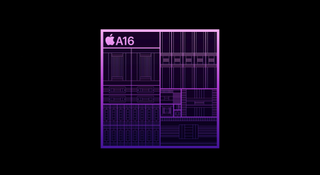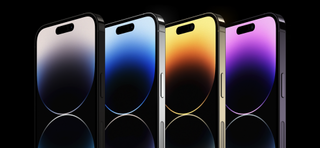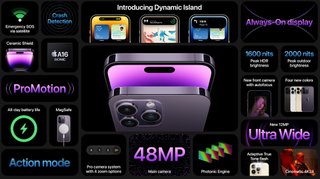Apple A16 Bionic SoC to Power iPhone 14 Pro
iPhone 14 will use A15 with a 5-core GPU.

Apple has introduced a new system on a chip, the A16 Bionic, that is powering the iPhone 14 Pro and iPhone 14 Pro Max.
The new chip features 16 billion transistors — the most in an iPhone — and is Apple's first chip on a 4 nm process. The 6-core CPU has two performance cores and 4 high-efficiency cores, which Apple says uses one third of the power of its competition. There's also a 5-core GPU and 16-core neural engine, along with a new display engine that powers the new high peak brightness, anti-aliasing, always-on display and 1 Hz refresh rate. The neural engine can confirm 17 trillion operation per second, and the chip can perform 4 trillion OPS per photo.
The new Pro lineup ditches Apple's trademark notch for a pill-shaped cutout on the screen, which Apple calls the "dynamic island." The new, smaller TrueDepth camera will fit behind the smaller cutout, and also mix with the screen to showcase notifications, and show charging status, calls, and AirPod pairing. It's an interesting mix of hardware and software that, on first impression from the video, appears pretty seamless.

Apple's new camera system includes a 48 megapixel camera with a quad-pixel sensor. That's 65% larger than the iPhone 13 Pro. There's also a 12MP ultra-wide camera and 12MP telephoto. Like the regular iPhone 14, the cameras will support the new Action Mode for videos with lots of motion without the need for a gimbal.

There will be two screen sizes: 6.1 and 6.7 inches, and these will be the first iPhone screens with always-on features. It can go as low as 1 Hz with low-power mode, and the lock screen can dim to use minimal power. Last year, Apple moved to a 120 Hz display with the iPhone 13 Pro.
Apple will keep the A15 Bionic around for the iPhone 14 and iPhone 14 Plus. Both will use the version that was in the iPhone 13 Pro line last year, with a 5-core GPU.
Both the iPhone 14 and iPhone 14 Pro will also be able to connect to emergency services via satellite when you're out of cellular range, and will have crash detection, which can call for help if you're in a car accident.
The iPhone 14 Pro will start at $999 while the Pro Max will start at $1,099. Pre-orders start on Sept. 9, and the phones will be available on Sept. 16.
Stay on the Cutting Edge
Join the experts who read Tom's Hardware for the inside track on enthusiast PC tech news — and have for over 25 years. We'll send breaking news and in-depth reviews of CPUs, GPUs, AI, maker hardware and more straight to your inbox.
Andrew E. Freedman is a senior editor at Tom's Hardware focusing on laptops, desktops and gaming. He also keeps up with the latest news. A lover of all things gaming and tech, his previous work has shown up in Tom's Guide, Laptop Mag, Kotaku, PCMag and Complex, among others. Follow him on Threads @FreedmanAE and Mastodon @FreedmanAE.mastodon.social.
-
blargh4 Pretty puzzled how the front camera cutout is supposed to be an improvement over the notch. You get a useless sliver of extra display and it looks like it cuts even deeper into the active screen area.Reply -
TCA_ChinChin Only use I see for dynamic island is if they dynamically arrange it back to the way the iPhone 13 had it, cause damn that cutout looks ugly. I know Apple likes to take their time implementing features but they really just took a camera cutout from 2017 and patched it up with some UI bandaids.Reply -
The Historical Fidelity I don’t understand how an always on display is better than one that turns off when not used. I do like the 1hz option though. The screen only needs to be at 120 ha if the user is navigating or watching videoReply -
warezme Reply
I have the Z-Flip4 but I use the always on display with the phone fully open and on a wireless charge stand in low light mode as my alarm and time clock on the bedside. It also has the always on display on the small screen when closed to view the time and alerts and really doesn't chew up any noticeable amount of battery life. It's just a convenient feature not needing to push buttons and accidentally triggering a bright screen when you don't need one. I have been using the always on screen since the Galaxy S9 years ago.The Historical Fidelity said:I don’t understand how an always on display is better than one that turns off when not used. I do like the 1hz option though. The screen only needs to be at 120 ha if the user is navigating or watching video
Most Popular



